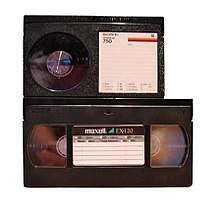
- Susan Morem (2009).

Video killed the radio star. ~ The Buggles (1980).

Prior to tape recording technology, most television programs were broadcast live with no recording or archiving. Film was used for some events and broadcasts, but it was expensive. This fundamentally changed the approach of television stations, enabling them to record shows, and also to archive and re-broadcast them as repeats.
However, VCRs also shook up the entertainment industry in other ways. Actors and writers went on strike in 1985 over the percentage paid to them for work released on video.
VCRs were also blamed for reducing movie theatre attendance and putting a damper on box-office takings over the 1985 summer season. ~ Allan Foster (2016))
However, VCRs also shook up the entertainment industry in other ways. Actors and writers went on strike in 1985 over the percentage paid to them for work released on video.
VCRs were also blamed for reducing movie theatre attendance and putting a damper on box-office takings over the 1985 summer season. ~ Allan Foster (2016))

Of the seventeen OAVs released during 1984, six were "general" and eleven were pornographic. In 1985, after the viability of the direct-video market for action-adventure anime had been established, the total was 28 action-adventure titles to just another eleven porno titles. The Japanese domestic OAV market has grown accordingly, over the past decade, with 1997's output of 162 "general" titles and 62 erotic titles (including some multiple volumes of series) being about the average ratio. ~ Fred Patten

The launch of cable television redefined television in the 1980s. While there was an obvious audience for 24-hour news and movies, making CNN and HBO almost sure-things from launch, music videos weren't looked upon as having much value at all. When MTV launched with cheap music videos, nobody anticipated that it would revolutionise entertainment. ~ Cameron Williams

Blockbuster’s early value proposition when it opened its first store 25 years ago was relatively revolutionary, as it provided consumers local access to thousands of movie titles all in one place. It was by no means the first video rental company, but it achieved scale in a way no one else did. ~ Ryan Lawler
Video is an electronic medium for the recording, copying, playback, broadcasting, and display of moving visual media.
Quotes
- Every day, there's another story about fiber-optic technology, 500 channels, video on demand,' says Greg Fairbanks, [[[w:Blockbuster LLC|Blockbuster]]'s] chief financial officer. Those developments may someday allow viewers to choose from hundreds of movies that would be delivered to TVs over cable or phone lines at any time. That could eliminate the need for a trip to the video store — and, to hear some tell it, eliminate Blockbuster. 'But those stories just complicate our story.
- Greg Fairbanks in USA Today, April 30, 1993; as qtd in Hailey Eber, “The rise and fall of Blockbuster Video”, (September 24, 2010).
- Prior to tape recording technology, most television programs were broadcast live with no recording or archiving. Film was used for some events and broadcasts, but it was expensive. This fundamentally changed the approach of television stations, enabling them to record shows, and also to archive and re-broadcast them as repeats.
However, VCRs also shook up the entertainment industry in other ways. Actors and writers went on strike in 1985 over the percentage paid to them for work released on video.
VCRs were also blamed for reducing movie theatre attendance and putting a damper on box-office takings over the 1985 summer season.- Allan Foster, “Please rewind: a final farewell to the VCR”, The Conversation, (July 31, 2016).
- In 1981, only 3% of Australian households (or 150,000 homes) had a VCR. That number rose quickly, and by 1993 80% of Australian households (4.5 million homes) had a VCR.
One reason for the rapid uptake was the dramatic drop in price of VCR technology. In 1976, the average price of a VCR was A$4,684 (A$8,838 in today’s dollars). By 1993, the average price was less than 10% of the 1976 price, at A$446 (A$842 in today’s money).
The number of movies available also skyrocketed, from a measly two films in 1978 to 33,000 titles in 1993.- Allan Foster, “Please rewind: a final farewell to the VCR”, The Conversation, (July 31, 2016).
- Countries which do not have the facilities and resources to produce films for theatrical release are using video format to reach their audiences. As shown in Table 6, Nigeria–with an average production of 1,000 movies per year –is the third largest producer in terms of volume. As a result of new technology and video production, the emergence of new film producers, such as Mauritius, has been possible. While the country did not produce any feature films before 2009, Mauritius increased its production from 19 to 30 films between 2010 and 2011.
- Roque González, "Emerging Markets and the Digitization of the Film Industry An analysis of the 2012 UIS International Survey of Feature Film Statistics", UIS information paper #14 (August 2013), p. 13.
- As one industry insider argued, "Saving Private Ryan suffers on [video] cassette. If you see it at home, you are by no means as impressed with it as you were in the movie theater. And Shakespeare in Love is a more intimate picture, it plays well on cassette. It may actually be enhanced by watching it at home."" In response, Dreamworks' marketing chief, Terry Press countered: "That goes to a larger issue. You're a member of the Motion Picture Academy, not the television video academy. These movies are meant to be seen in movie theaters, all of them. They're not meant to be stopped and started and paused when the phone rings or to feed the dog."
- Barbara Klinger, “Beyond the Multiplex: Cinema, New Technologies, and the Home”, University of California Press, 2006, p. 2.
- Every video I'm in, every magazine cover, they stretch you; they make you perfect. It's not real life.
- Lady Gaga, in: Amber L. Davisson (2013). Lady Gaga and the Remaking of Celebrity Culture. p. 162
- People want to watch whatever video they want to watch whenever they want to watch.
- Bill Gates in: "Bill Gates on … the Competition," The Wall Street Journal, June 19, 2006.
- Blockbuster’s early value proposition when it opened its first store 25 years ago was relatively revolutionary, as it provided consumers local access to thousands of movie titles all in one place. It was by no means the first video rental company, but it achieved scale in a way no one else did, using its vast reach to dominate the video rental landscape and drive hundreds of local mom-and-pop video stores out of business. For many, Blockbuster provided the convenience of a one-stop shop for nearly any video title one would hope to watch. But over the years, viewers and viewing habits have changed in a way that made Blockbuster less relevant. It’s no longer enough to provide users with a way to get content from a store down the street; nowadays, they want access to that content in their living rooms. At first the mail, and then online video gave them that access.
- Ryan Lawler, Gigaom; as qtd. in John Hudson, “Blockbusted: The Rise and Fall of a Video Chain”, The Atlantic, (September 23, 2010).
- In a phenomenal growth spurt that has reshaped the $10-billion-a-year video business, Blockbuster has gone from 19 stores nationally to nearly 1,300 in three years....
- Los Angeles Times, July 22, 1990; as qtd in Hailey Eber, “The rise and fall of Blockbuster Video”, (September 24, 2010).
- When you see yourself on video, do you like what you see? I've yet to meet someone who says yes.
- Susan Morem (2009). How to Gain the Professional Edge, Second Edition, p. 45.
- When the first anime-genre videos were released in 1990-91 through mail order and direct sales to the comic-book fandom specialty stores, it was understood by this market that these were animated equivalents of movies like The Terminator and Die Hard, full of explosions, blood-'n-guts, adult dialogue, and often a brief risqué nude scene. Around 1994 the anime videos expanded into the major video mass-market chains and became accessible to the general public, which tends to assume automatically that all animated cartoons are safe for children. This resulted in the necessity for warning advisories on the video boxes such as "Contains violence and nudity;" "Contains brief nudity and mature situations. Parental discretion advised;" and, "Recommended for Mature Viewers." But these did not yet include explicit sexual titles.
- Fred Patten, “The Anime "Porn" Market”, Animation World News, (July 1, 1998).
- Japanese animated explicitly adult cartoons developed along with the general animated Direct-to-video market. The first Japanese Original Animated Video (OAV) title was a science-fiction drama, Dallos, released in December 1983. The third OAV release, on February 21, 1984, was Lolita Anime I: Yuki no Kurenai Kesho * Shojo Bara Kei (freely translated, Crimson Cosmetic on the Snow * Young Girls' Rose Punishment). This half-hour video, first in the short-lived Wonder Kids erotic anime series, consisted of two 15-minute dramas of rape and sadistic sexual torture/murder of schoolgirls, whose spirits exact a gruesome supernatural vengeance. Of the seventeen OAVs released during 1984, six were "general" and eleven were pornographic. In 1985, after the viability of the direct-video market for action-adventure anime had been established, the total was 28 action-adventure titles to just another eleven porno titles. The Japanese domestic OAV market has grown accordingly, over the past decade, with 1997's output of 162 "general" titles and 62 erotic titles (including some multiple volumes of series) being about the average ratio.
- Fred Patten, “The Anime "Porn" Market”, Animation World News, (July 1, 1998).
- All of the books in the world contain no more information than is broadcast as video in a single large American city in a single year. Not all bits have equal value.
- Carl Sagan & P.K. Ahnelt, (1998). "The photoreceptor mosaic." Eye 12(3B):531–540; as cited in: Stefan Winkler (2013). Digital Video Quality: Vision Models and Metrics. p. 138
- Just as the spinning and gathering of wool serve as the raw material for a weave, so the artist working with video selects images to serve as the basic substance of the work. All technology, in its capacity to instantly reproduce, store, and retrieve information, has moved continually in a direction that seeks to free us from laboring with our hands by giving us greater conceptual freedom to organize, select, and judge.
- Ira Schneider, Beryl Korot (1976). Video art: an anthology. p. 76
- Video killed the radio star.
- The Buggles "Video Killed the Radio Star" in: The Age of Plastic (1980)
- When I started in video I was one of two or three dozen video artists in 1970. And now, to paraphrase Andy Warhol, everyone's a video artist. Video, through your cellphone and camcorder, has become a form of speech, and speech is not James Joyce. It's great, and to be celebrated, but it has to find its own level.
- Bill Viola, in: Leo Benedictus. "Tomorrow's world," in; The Guardian, Wednesday 12 July 2006.
- The launch of cable television redefined television in the 1980s. While there was an obvious audience for 24-hour news and movies, making CNN and HBO almost sure-things from launch, music videos weren't looked upon as having much value at all. When MTV launched with cheap music videos, nobody anticipated that it would revolutionise entertainment.
- Cameron Williams, “How MTV changed the world with its industry of cool”, SBS.com, (13 Feb 2017).
- Music videos were in short supply at the beginning of the 80s, so MTV played whatever they could get their hands on. Many record companies in America didn’t believe in MTV and weren’t willing to provide music videos at their own cost. A bulk of the music videos MTV played came from Europe where record companies made short promotional films for their artists to be played on video jukeboxes - a popular new piece of technology at the time. With only 250 music videos being played over a 24-hour period, the early artists of MTV got a lot of exposure thanks to a combination of repetition and desperation.
- Cameron Williams, “How MTV changed the world with its industry of cool”, SBS.com, (13 Feb 2017).
- While a polemical argument in prose may reach tens of thousands of the usual suspects - formally educated people who like to follow such texts - the video version reached far beyond that audience.
- Naomi Wolf, "Smugglers of truth," The Guardian, 19 January 2009.
- For all the power of video and film, I am not giving up my pen. I am just much more likely to try to link essays to webcasts or videos. The best way for these two media to move forward, to inform and make change, is in tandem; together they are more than the sum of their parts.
- Naomi Wolf, "Smugglers of truth," The Guardian, 19 January 2009.
- By 1990, movies were either rented or sold at much more reasonable prices directly to consumers (known as sell-through). Video rentals reached a plateau, but video sell-through sales continued to grow. By 1992, the value of video sell-through sales exceeded the domestic theatrical box office for the first time. Home video caused a significant downward shift in the box office; for instance, the domestic box office represented 80% of studio revenues in 1980, but by 1992 it decreased to no more than 25%.
- S. Mark Young, James J. Gong, and Wim A. Van der Stede, “The Business of Making Money with Movies", Strategic Finance, February 2010, p. 38.
See also
External links
This article is issued from
Wikiquote.
The text is licensed under Creative
Commons - Attribution - Sharealike.
Additional terms may apply for the media files.